A Sense of Doubt blog post #2026 - Mets Legend Tom Seaver dies - RIP
ABOVE:
 I love Baseball, which is a well known passion by all my friends and family and any of you readers who may have visited my blog more than once.
I love Baseball, which is a well known passion by all my friends and family and any of you readers who may have visited my blog more than once.I also loved Tom Seaver, despite not playing for any teams that are really favorites of mine.
He was a childhood hero.
Though I was not fully aware of the Miracle Mets of 1969, as I was seven, and just starting to buy Baseball cards but not fully invested in the sport until 1971 and the black card below.
 Once I became a huge fan, I read about the Miracle Mets and fell in love with the class, skill, athleticism, and style of the great Tom Seaver.
Once I became a huge fan, I read about the Miracle Mets and fell in love with the class, skill, athleticism, and style of the great Tom Seaver.I watched his 300th winning game in 1985.
When I learned of his death, I dug out the biography I owned of Seaver and started to re-read portions.
I am still in the "break" from time-consuming blog creation with lots of original content.
But things happen.
Tom Seaver died, and I have to pay homage to one of my childhood heroes.

Seaver's Career By The Numbers
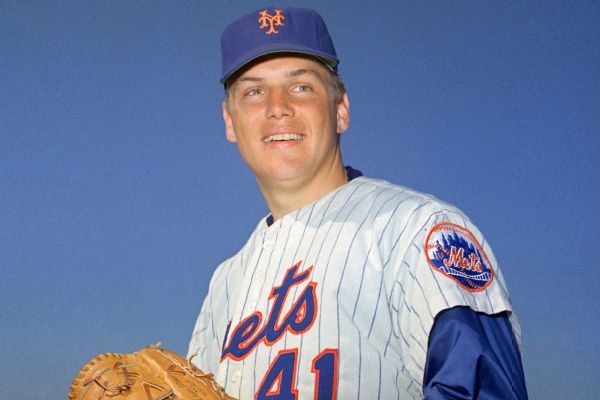
• 1967 NL Rookie of the Year
• 3-time Cy Young Award winner ('69, '73, '75)
• 12-time All-Star
• '69 World Series champion
• Inducted into Baseball HOF in '92
• 311 career wins (18th all time)
• 3,640 career K's (sixth all time)
• 9 straight 200-K seasons (longest streak in MLB history)
• 1 of 8 pitchers with 3,500 K's and 300 wins
• Only player in MLB history to strike out 10 straight batters
• 3-time Cy Young Award winner ('69, '73, '75)
• 12-time All-Star
• '69 World Series champion
• Inducted into Baseball HOF in '92
• 311 career wins (18th all time)
• 3,640 career K's (sixth all time)
• 9 straight 200-K seasons (longest streak in MLB history)
• 1 of 8 pitchers with 3,500 K's and 300 wins
• Only player in MLB history to strike out 10 straight batters
https://www.espn.com/mlb/story/_/id/29797239/tom-seaver-hall-fame-pitcher-mets-legend-dies-75
Sep 2, 2020
NEW YORK -- Tom Seaver transformed a franchise and captivated a city, setting enduring standards as he whipped his powerful right arm overhead for the Miracle Mets and dirtied his right knee atop major league mounds for two decades.
A consummate pro and pitching icon, he said he was fulfilled after a career remembered with awe long after his final strikeout.
"It is the last beautiful flower in the perfect bouquet," Seaver said on the afternoon he was inducted into baseball's Hall of Fame.
Seaver, the galvanizing force who steered the New York Mets from the National League cellar to a stunning World Series title in 1969, has died. He was 75.
The Hall said Wednesday night that Seaver died Monday from complications of Lewy body dementia and COVID-19. Seaver spent his final years in Calistoga, California.
Seaver's family announced in March 2019 that he had been diagnosed with dementia and had retired from public life. He continued working at Seaver Vineyards, founded by the three-time NL Cy Young Award winner and his wife, Nancy, in 2002 on 116 acres at Diamond Mountain in the Calistoga region of Northern California.
Seaver was diagnosed with Lyme disease in 1991, and it reoccurred in 2012 and led to Bell's palsy and memory loss, the Daily News of New York reported in 2013.
"He will always be the heart and soul of the Mets, the standard which all Mets aspire to," Mike Piazza, a former Mets catcher and Hall of Famer, tweeted when Seaver's dementia diagnosis was announced.
Said ex-Mets closer and captain John Franco: "As a kid, you always wanted to be Tom Seaver."
Nicknamed "Tom Terrific" and "The Franchise," Seaver was a five-time 20-game winner and the 1967 NL Rookie of the Year. He went 311-205 with a 2.86 ERA, 3,640 strikeouts and 61 shutouts during an illustrious career that lasted from 1967 to 1986. He became a constant on magazine covers and a media presence, calling postseason games on NBC and ABC even while still an active player.
"He was simply the greatest Mets player of all-time and among the best to ever play the game," Mets owner Fred Wilpon and son Jeff, the team's chief operating officer, said in a statement.
Seaver was elected to the Hall of Fame in 1992 when he appeared on 425 of 430 ballots for a then-record 98.84%. His mark was surpassed in 2016 by Ken Griffey Jr., again in 2019 when Mariano Rivera became the first unanimous selection by baseball writers, and in 2020 when Derek Jeter fell one vote short of a clean sweep.
"Tom was a gentleman who represented the best of our national pastime," commissioner Rob Manfred said in a statement. "He was synonymous with the New York Mets and their unforgettable 1969 season.
"After their improbable World Series championship, Tom became a household name to baseball fans -- a responsibility he carried out with distinction throughout his life," he said.
Seaver's plaque in Cooperstown lauds him as a "power pitcher who helped change the New York Mets from lovable losers into formidable foes." He changed not only their place in the standings but the team's stature in people's minds.
"Tom Seaver hated to lose," said Jerry Grote, his longtime catcher with the Mets. "In May of 1969, we had a celebration in the locker room when we reached .500 for the first time. Tom said, 'We want more than .500, we want a championship.'"
Seaver pitched for the Mets from 1967 to 1977, when he was traded to Cincinnati after a public spat with chairman M. Donald Grant over Seaver's desire for a new contract. It was a clash that inflamed baseball fans in New York.
"My biggest disappointment? Leaving the Mets the first time and the difficulties I had with the same people that led up to it," Seaver told The Associated Press ahead of his Hall induction in 1992. "But I look back at it in a positive way now. It gave me the opportunity to work in different areas of the country."
Hall of Fame manager Sparky Anderson, who had Seaver on his 1977 and '78 Reds teams, said, "My idea of managing is giving the ball to Tom Seaver and sitting down and watching him work."
Seaver threw his only no-hitter for the Reds in June 1978 against St. Louis and was traded back to New York after the 1982 season. But Mets general manager Frank Cashen blundered by leaving Seaver off his list of 26 protected players, and in January 1984 he was claimed by the Chicago White Sox as free-agent compensation for losing pitcher Dennis Lamp to Toronto.
While pitching for the White Sox, Seaver got his 300th win at Yankee Stadium and did it in style with a six-hitter in a 4-1 victory. He finished his career with the 1986 Boston Red Sox team that lost to the Mets in the World Series.
"Tom Seaver was one of the best and most inspirational pitchers to play the game," Reds chief executive officer Bob Castellini said in a statement. "We are grateful that Tom's Hall of Fame career included time with the Reds. We are proud to count his name among the greats in the Reds Hall of Fame. He will be missed."
Supremely confident -- and not necessarily modest about his extraordinary acumen on the mound -- Seaver was a 12-time All-Star who led the major leagues with a 25-7 record in 1969 and a 1.76 ERA in 1971. A classic power pitcher with a drop-and-drive delivery that often dirtied the right knee of his uniform pants, he won Cy Young Awards with New York in 1969, 1973 and 1975. The club retired his No. 41 in 1988, the first Mets player given the honor.
"From a team standpoint, winning the '69 world championship is something I'll remember most," Seaver said in 1992. "From an individual standpoint, my 300th win brought me the most joy."
Seaver limited his public appearances in recent years. He did not attend the Baseball Writers' Association of America dinner in 2019, where members of the 1969 Mets were honored on the 50th anniversary of what still ranks among baseball's most unexpected championships.
Five months later, as part of a celebration of that team, the Mets announced plans for a statue of Seaver outside Citi Field, and the ballpark's address was officially changed to 41 Seaver Way in a nod to his uniform number.
Seaver did not attend those ceremonies, either, but daughter Sarah Seaver did and said her parents were honored.
"This is so very appropriate because he made the New York Mets the team that it is," said Ron Swoboda, the right fielder whose sprawling catch helped Seaver pitch the Mets to a 10-inning win in Game 4 of the '69 Series against Baltimore. "He gave them credibility."
Seaver's death was announced, in fact, hours after the Mets beat the Orioles in an interleague game.
"Just a class act. Just a gentleman in the way he handled himself, and really the way handled his whole career," said Miami manager Don Mattingly, a former New York Yankees captain. "We just left New York, and every time you walk in a door there, it's like Tom Seaver Hall, with different pictures."
When the Mets closed their previous home, Shea Stadium, on the final day of the 2008 regular season, Seaver put the finishing touches on the nostalgic ceremonies with a last pitch to Piazza, and the two walked off together waving goodbye to fans.
"He was a star. A shining star,'' Mets teammate Ed Kranepool said. "No one can replace Tom Seaver."
Seaver is survived by Nancy, daughters Sarah and Anne, and grandsons Thomas, William, Henry and Tobin.
George Thomas Seaver was born in Fresno, California, on Nov. 17, 1944, a son of Charles Seaver, a top amateur golfer who won both his matches for the U.S. over Britain at the 1932 Walker Cup.
Tom Seaver was a star at the University of Southern California and was drafted by Atlanta in 1966. He signed with the Braves for $51,500 only for commissioner William Eckert to void the deal. The Trojans already had played exhibition games that year, and baseball rules at the time prohibited a club from signing a college player whose season had started. Any team willing to match the Braves' signing bonus could enter a lottery, and Eckert picked the Mets out of a hat that also included Cleveland and Philadelphia.
Among baseball's worst teams from their expansion season in 1962, the Mets lost more than 100 games in five of their first six seasons and had never won more than 73 in any of their first seven years. With cherished Brooklyn Dodgers star Gil Hodges as their manager, a young corps of pitchers led by Seaver, Jerry Koosman, Gary Gentry and a still-wild Nolan Ryan, and an offense that included Cleon Jones and Tommie Agee, the Mets overtook the Chicago Cubs to win the NL East with a 100-62 record in 1969.
They swept Hank Aaron and the Atlanta Braves in the first NL Championship Series to reach the World Series against highly favored Baltimore, which had gone 109-53. Seaver lost the opener 4-1 in a matchup with Mike Cuellar, then pitched a 10-inning six-hitter to win Game 4, and the Mets won the title the following afternoon.
Seaver was an All-Star in each of his first seven seasons. Aaron introduced himself to Seaver at the pitcher's first All-Star Game in 1967.
"Kid, I know who you are, and before your career is over, I guarantee you everyone in this stadium will, too," Aaron said.
For Seaver, that All-Star appearance made him feel like he belonged.
"I may have been paid before, but that's when I really became a professional," he said.
Perhaps Seaver's most memorable moment on the mound was at Shea Stadium on July 9, 1969, when he retired his first 25 batters against the Chicago Cubs. Pinch hitter Jimmy Qualls looped a one-out single to left-center in the ninth inning before Seaver retired Willie Smith on a foul out and Don Kessinger on a fly out.
"I had every hitter doing what I wanted," Seaver recalled in 1992. "Afterward, my wife was in tears and I remember saying to her: 'Hey, I pitched a one-hit shutout with 10 strikeouts. What more could I ask for?'"
The Associated Press contributed to this report.
 |
| https://www.sportingnews.com/us/mlb/news/tom-seaver-greatest-mets-franchise/1ni82imbh558i1fl2lk4gjxu66 |
Mets honor Tom Seaver's iconic drop-and-drive delivery with dirty knees
https://www.espn.com/mlb/story/_/id/29804025/mets-honor-tom-seaver-iconic-drop-drive-delivery-dirty-knees
NEW YORK -- Far too young to remember Tom Seaver's glory days, Pete Alonso and the New York Mets found a perfect way to pay tribute to the greatest player in franchise history.
Starting pitcher Robert Gsellman, his right knee already dirtied, led the Mets from the dugout onto the diamond at Citi Field on Thursday to face the New York Yankees. Every teammate who followed him had a smudge of dirt in the same spot along the right knee.
What better symbol to honor Seaver, the Mets icon and Hall of Famer whose classic, drop-and-drive, power-pitcher delivery was imitated by thousands of Little Leaguers in the 1960s and 1970s?
When Seaver's delivery was dialed in, his right knee often accumulated dirt over the course of an outing on the mound.
Seaver, known for decades simply as "The Franchise," died Monday at the age of 75 due to complications from Lewy body dementia and the coronavirus. His death was announced Wednesday night, a few hours after New York beat the Baltimore Orioles -- the team Tom Terrific and the Miracle Mets toppled in the 1969 World Series.
"He turned the organization around from a laughingstock ballclub into a complete team instantly," said Ed Kranepool, who spent his entire 18-year career with the Mets. "You knew every time out you were going to be a competitive team.
"It's a sad day in Metsville," he said. "We lost our star and our leader."
Hours later, Alonso hit a two-run homer in the 10th inning that lifted the Mets over the Yankees 9-7.
"I think that this is a really special win not just for us, but for anybody who knows about the Mets or knows about Tom Seaver," said Alonso, the NL Rookie of the Year last season. "This is a really meaningful and special day. Really, really happy that we could get it done in the way that we did.''
Before the final Subway Series game of the season -- played at a ballpark without fans due to the pandemic -- the Mets and Yankees both paid their respects to Seaver, who pitched for the Mets from 1967 through 1977 and again in 1983 before spending five seasons as a Yankees broadcaster.
"We're actually family friends with the Seavers," Yankees manager Aaron Boone said. "In the '81 strike, my dad was a National League rep and the Seavers came and stayed with us for like a week. I was 8 years old. Tom and I were out messing around, and Tom was on a moped. I actually jumped on the back to get on the moped with him and burnt my calf on the muffler. And I still have the scar."
Both teams stood in front of their dugouts for a pregame video montage and a moment of silence. After the Mets took their positions for the top of the first, the Yankees joined the Mets in doffing their caps toward Seaver's 41 hanging along the left-field upper deck.
The Mets hung Seaver's jersey in their dugout. The Seaver Gate at Citi Field -- located at 41 Seaver Way -- was adorned with black bunting, and some fans placed flowers at the entrance.
The scoreboard displayed the same graphics used in 1969. Beginning this weekend, the Mets will sport a uniform patch honoring Seaver, whose arrival transformed the club's fortunes.
"You put a bunch of guys together of varying abilities and you know who the great ones are," former Mets outfielder Ron Swoboda said. "When you played behind Tom Seaver, you were playing behind greatness. And you saw it almost every time."
Swoboda is among many who have pushed for a Seaver statue at Citi Field, close to where the pitcher dominated for so long at Shea Stadium.
A statue seems likely by the 2021 season, and Swoboda has an idea of how it should look.
"His motion was so iconic," said Swoboda, who played for the Mets from 1965 through 1970. "I would love to see something out there. I'd love to see them capture his motion from right at delivery, with his knee that close to the mound as he comes through. And its follow-through -- it was so iconic."
"As Seaver fans are well aware, when he gets a dirt smudge on the right knee of his pants, it means he's sharp," wrote Sports Illustrated in 1983.
Tributes to Seaver poured in from the sports world and beyond. Sports radio station WFAN in New York was filled with calls from fans reminiscing about Seaver, a three-time NL Cy Young Award winner with 311 career victories.
"Baseball lost the best pitcher of my era," tweeted Orioles Hall of Fame pitcher Jim Palmer, who finished with the same 2.86 ERA as Seaver.
Hall of Fame slugger Hank Aaron recalled meeting Seaver at the pitcher's first All-Star Game "and I knew he was a special person."
"He was a terrific pitcher and a wonderful friend. I was lucky to have dinner in his home in New York and in California which I remember fondly," Aaron posted on Twitter.
Comedian Adam Sandler seemed to speak for many fans and their families when he posted on Twitter: "Tom Seaver. My dad loved him. My brother loved him. I loved him. A hero to so many."
Mets broadcaster Keith Hernandez, who played with and against Seaver, choked up while talking about him on a pregame show. Fellow announcer and big leaguer Ron Darling said Seaver "was like a big brother to me" during days of playing bridge, doing crossword puzzles and having dinner on the road.
New York Gov. Andrew Cuomo ordered all flags at Mets-affiliated ballparks in the state to fly at half-staff to pay tribute to Seaver.
ESPN's Joon Lee and The Associated Press contributed to this report.

https://www.espn.com/mlb/story/_/id/29802799/tom-seaver-why-somes-really-meet-your-heroes
Tom Seaver and why sometimes you really should meet your heroes
By the time I was 5 I would come to understand that Superman, Batman and Spider-Man were not actually somewhere outside our apartment on West 10th Street.
That wasn't true of Tom Seaver. He was the superhero we could go see in Queens.
The best pitcher in the game was on my team, had my name, wore the same cap I had. He would certainly understand why I took a black felt-tip pen and, with great deliberation, consecrated the back of my pinstriped Mets shirt with a ragged "41."
I never forgave my parents for leaving New York City to move to Iowa (long story), but even in that foreign land, when I traced my finger over the raised orange stitches of the "NY" on my cap, the same as his cap, with "Tom Seaver" scrawled under the brim in black felt-tip pen, I knew he was out there. Until an 8-year-old learned about the oblivious cruelty of the adult world through a trade to the Reds. My parents had Walter O'Malley and I had M. Donald Grant.
Even while he was in Cincinnati, Tom Seaver was mine, and I knew that if he could leave, that meant he could come back. He did come back to the Mets in 1983, and then I learned the agony that comes with wanting something to be the way it was. Seaver was 9-14 that season. It wasn't such a great year for my parents, either; they split up for good.
One of the first things I learned as a young baseball writer was that you'd better be prepared to hear some awful things about the men you admired as a boy. That knowing laugh you'd get from the older writers when you asked if this or that Hall of Famer was a "good guy." Eventually you stop asking.
So when I was covering the Mets in 1999 and it was announced that Tom Seaver was returning to the club as an announcer and instructor, I had the scars of almost three decades to gird me for one more disappointment, what I knew would be the most painful of all.
Tom Terrific arrived in Port St. Lucie late, and he toured the camp in a chauffeured golf cart as though he were riding in a chariot. He reveled and waved the way Roman gods do and he was clearly pleased that he was Tom Seaver. At the end of the day, we newspaper writers waited in the dugout for our audience. He was late for that, too. I turned to Mike Vaccaro of the New York Post, who shared my age and Mets breeding, and I said, "I don't care who he is, I'm going to rip him." Vac nodded.
When Seaver did finally take his seat on the dugout bench, he apologized. He was engaging and charming, but I knew with the insight of a now-jaded 29-year-old sportswriter that this was just the act that legends trot out for those on the outside.
I wish I remembered what I said, but at one point I cracked a little joke and Tom Seaver broke up. Fully and loudly. I blushed. Vac leaned over and whispered, "That was awesome." I whispered back, "I know."
No other living person could have made me feel that way. Batman could not have made me feel that way. The 8-year-old who had cried over a baseball trade was still there and couldn't wait to get to a phone to tell his parents, even if I had to make separate calls to do it.
Tom Seaver thought I was funny. Tom Seaver would come to know my name. Tom Seaver would take my calls in the offseason. He told me about something funny his wife, Nancy, had said, about how his grapes had come in that summer, about how my son had to learn to slap that front foot down if he wanted to throw a great slider.
Yes, Tom Seaver knew exactly how great he was, but he also knew his greatness was not his to keep to himself because it meant a considerable deal to people like me. He tended to his legend as he would his grapes, and I knew that he rode around the golf cart like Caesar because that's who the citizens of the Mets empire needed him to be, the greatest player from their greatest team.
"Did I ever tell you about the dinner I organize at Cooperstown every year?" he said once. "It's me, Sandy Koufax, Bob Gibson, Gaylord Perry and Warren Spahn. Sandy and Gibby are the only ones without 300 wins. You know what we call them?" He paused. "Our fourth and fifth starters."
We roared together in laughter and I immediately started thinking of who I could tell.
He once told me at the end of a conversation that he always liked talking baseball with me because I knew the game. I don't care if he meant it. Tom Seaver wanted me to feel like I belonged on the inside and god almighty was that good enough.
It has been a long time since I last spoke to him. It happens. Even with distance he was still mine, still ours. It was devastating to hear last year that he was retiring from public life because of his dementia, and that the former Marine with one of the sharpest minds in the game was fading badly.
And I'm reminded now that loving Tom Seaver always meant understanding that he might have to leave.
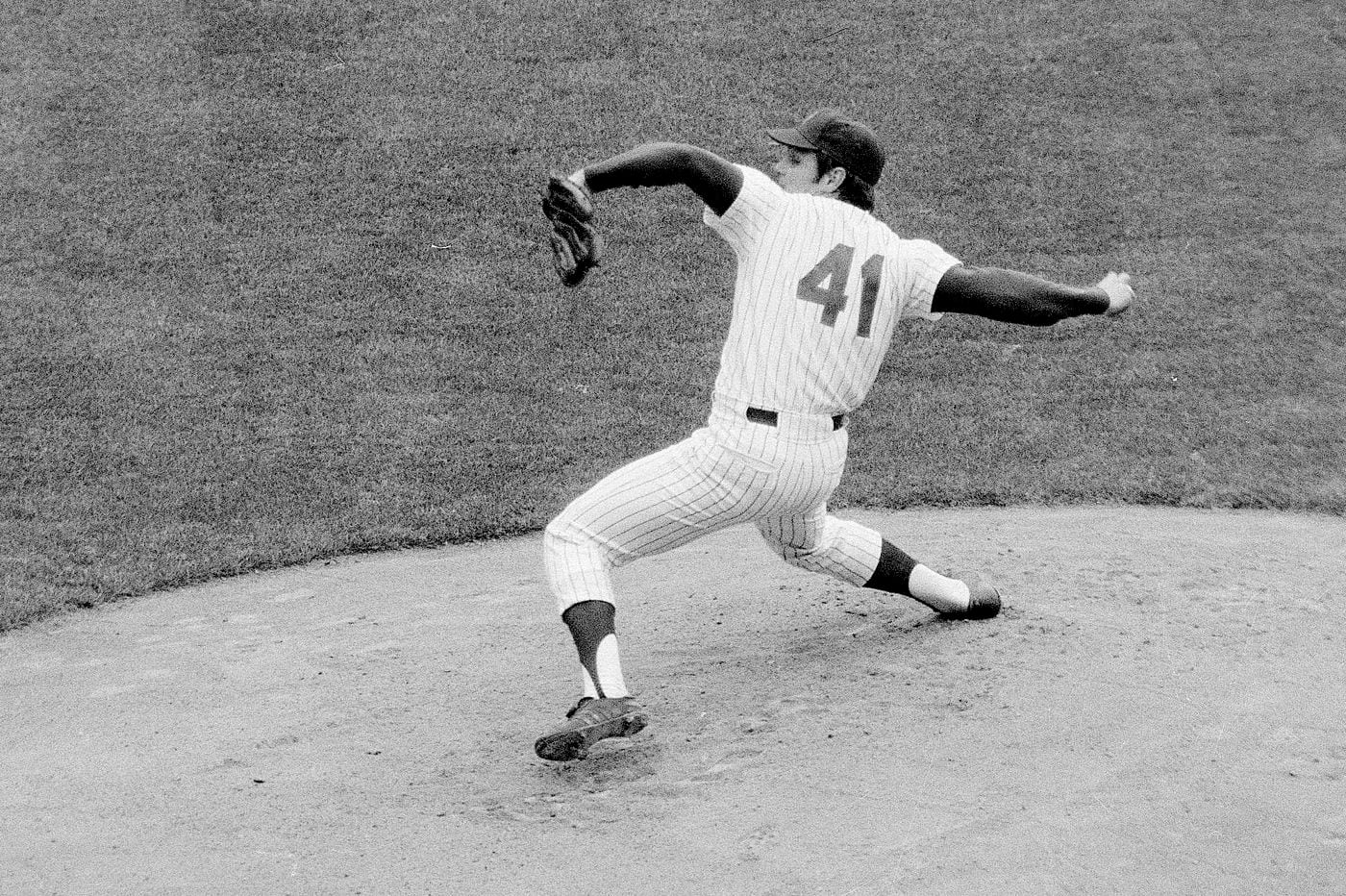 |
| https://www.inquirer.com/phillies/tom-seaver-dies-mets-tributes-twitter-20200902.html |
Tom Seaver transformed the New York Mets and transfixed their fans
https://www.espn.com/mlb/story/_/id/29798240/tom-seaver-transformed-new-york-mets-transfixed-their-fans
Fifty-one years later, it might still be the greatest baseball story ever told. The Miracle Mets of 1969, never having finished above .500, going from ninth place in 1968 to the World Series title. The hapless, bumbling, laughingstock New York Mets, most famous for the time Marv Throneberry hit an apparent game-winning triple only to have missed first base, with the Mets instead losing the game. Those luckless, atrocious Mets, whom Casey Stengel explained had selected a certain catcher in the expansion draft because they needed somebody to prevent the ball from rolling to the backstop.
That's how the Mets were born and, boy, were they bad. They lost 120 games that first season in 1962 and followed up with seasons of 111, 109 and 112 losses. In 1966, they climbed out of last place for the first time -- all the way up from 10th place to ninth. The fans in Queens loved them nonetheless. Even though the Mets lost 95 games that year, they finished second in the major leagues in attendance.
The transformation from lovable losers to champions began in 1967. It began with Tom Seaver.
The story of how Seaver landed with the Mets is a little miracle in itself. The Atlanta Braves had drafted the Southern California right-hander in the secondary phase of the January draft in 1966, a part of the draft that no longer exists and was reserved for players previously drafted who didn't sign. The Los Angeles Dodgers had drafted Seaver in the 10th round in 1965, but a Dodgers scout named Tommy Lasorda refused to meet Seaver's $70,000 asking price. Seaver returned to school.
Seaver and the Braves reached a deal in late February for a $40,000 bonus. USC's spring season had already started, however, and under baseball's rules, a team couldn't sign a player if his college season had begun. Commissioner Spike Eckert nullified the contract. Seaver then tried to return to school, but the NCAA declared him ineligible, even though he had yet to accept any money.
It was a classic Catch-22 situation. Seaver's dad threatened a lawsuit. Eckert, in an unprecedented move, set up a special lottery. Any team willing to match Atlanta's $40,000 bonus could participate, but the Braves were banned from signing Seaver for three years. Only three teams chose to get involved in the Seaver sweepstakes: the Philadelphia Phillies, Cleveland Indians and Mets. The Mets won the lottery.
Eckert explained his decision was "for the interest of the boy and the public. The youngster previously signed a contract with another club in good faith only to learn he had been improperly contracted," Eckert said. "It was not his fault that the contract was invalidated."
Did the Mets know what they were getting? It's perhaps noteworthy that only three teams thought he was worth that $40,000 bonus, though that was a sizable bonus for the time, more than most of the first-round picks would receive that June. Seaver had been lightly scouted in high school in Fresno, California, but he was just 5-foot-9 and 160 pounds as a senior in 1962. He spent the next year working in a packing plant and joined the Marine Corps Reserve. After a year at Fresno City College, he transferred to USC.
When Seaver initially agreed to the deal with the Braves, the Fresno Bee interviewed Braves scout Johnny Moore, the team's West Coast supervisor.
"We're very high on Tom's potential," Moore said. "We have watched him since he was a small lad in Fresno, and we especially kept our eye on him as he developed at Fresno City College and Southern Cal. As far as I'm concerned, there has been only one better deal since the free-agent draft setup [came] in effect last June. That was the signing of Rick Monday by Kansas City."
Monday had been the first pick in the first draft in 1965.
So while Seaver was only the 20th pick in the January phase, it was apparent he was an excellent prospect. The Fresno paper called him a "fireballing right-hander." It's possible that Seaver's bonus demands scared some teams away. His dad also thought Seaver's military commitment might have been an issue. "The Braves were the only club to go after him," Charley Seaver said, "possibly because of his military status."
But it's also possible some teams hadn't seen Seaver and that even though he had gone 10-2 with a 2.47 ERA for USC, his fastball didn't impress. Years later, Baseball America quoted a veteran scout from the area who said of Seaver: "Some clubs wouldn't give him more than $4,000 because he had a below-average fastball. But he pitched against a team called the Crosby All-Stars just before the draft and was facing active major leaguers. He struck out 12 in five innings."
The Fresno Bee didn't mention that game, but it did mention one outing for USC early in 1966 when Seaver threw five perfect innings against the San Diego Marines. The paper also said the Dodgers had reportedly offered Seaver $50,000 to sign in 1965.
Seaver was an immediate star in New York. He spent 1966 in the minors and reached the Mets in 1967, when he went 16-13 with a 2.76 ERA and won National League Rookie of the Year honors. He went 16-12 with a 2.20 ERA in 1968 as the Mets climbed out of the cellar. Still, after going 73-89, they weren't expected to do much in 1969, the first year the leagues were split into divisions.
Featuring a young rotation with the 24-year-old Seaver, 26-year-old Jerry Koosman, 22-year-old Gary Gentry, 25-year-old Jim McAndrew and 22-year-old part-time starter Nolan Ryan, the Mets allowed the second-fewest runs in the league. Seaver went 25-7 with a 2.21 ERA, winning the first of his three Cy Young Awards.
The Mets were seven games behind the Chicago Cubs on Aug. 21 but went 32-10 the rest of the way to win the division by eight games. Seaver started eight games in that stretch -- and went 8-0 with eight complete games and a 1.00 ERA. In Game 4 of the World Series against the heavily favored Baltimore Orioles, Seaver tossed a 10-inning complete game to win 2-1. Koosman wrapped it up the next day.
Seaver became known as Tom Terrific and rightly so. Since World War II, the only pitcher with a higher career WAR is Roger Clemens. Seaver was ahead of his time in more than his bonus demands. A 1972 profile by Pat Jordan in Sports Illustrated dug into Seaver's dedication to his craft and to lifting weights, an exercise that most players of his era avoided.
"He believes, unlike most pitchers and coaches, that a selective program of weight lifting will add speed to a pitcher's fastball," Jordan wrote. Indeed, in one of his autobiographies, Ryan mentioned seeing the "doughy" bodies of his fellow Mets pitchers and he too became an early proponent of lifting weights.
"Pitching is what makes me happy," Seaver told Jordan. "I've devoted my life to it. I live my life around the four days between starts. It determines what I eat, when I go to bed, what I do when I'm awake. It determines how I spend my life when I'm not pitching. If it means I have to come to Florida and can't get tanned because I might get a burn that would keep me from throwing for a few days, then I never go shirtless in the sun. If it means when I get up in the morning I have to read the box scores to see who got two hits off Bill Singer last night instead of reading a novel, then I do it. If it means I have to remind myself to pet dogs with my left hand or throw logs on the fire with my left hand, then I do that too. If it means in the winter I eat cottage cheese instead of chocolate chip cookies in order to keep my weight down, then I eat cottage cheese. I might want those cookies, but I won't ever eat them."
The suggestion was that Seaver wasn't a natural-born talent. He made himself into an all-time great. "Although he is not conscious of it, Seaver shows his disdain for men who he feels have not fulfilled their potential," Jordan wrote. "For Seaver, a man's talent is not just a part of the man. It is the whole man, or at the very least a mirror of the whole man."
Of course, Seaver wasn't without talent. I remember once talking to former ESPN baseball analyst Dave Campbell, who was in the lineup for the San Diego Padres the day Seaver fanned a record 10 batters in a row.
"He was so dominant that day, he could have told us what pitch was coming and we still wouldn't have hit it," Campbell said.
Now we mourn Seaver's death at age 75, with 1969 a distant, graying memory. I scroll through Facebook and see all the tributes from those who just lost their childhood hero.
"Thank you for being such a great role model," wrote my brother-in-law, Jeff Russo.
Geoff Reiss, the man who hired me so many years ago to work for ESPN's website, wrote: "This is so incredibly sad. He was my Mantle, Kobe, MJ." He posted a photo of his autographed Seaver jersey.
The legendary baseball writer John Thorn simply wrote: "Tom Seaver ... hail and farewell."
Many Mets fans say the saddest day of their youth was the day New York traded Seaver to the Cincinnati Reds. It's time to shed another tear.
 |
| https://www.nytimes.com/2020/09/02/obituaries/tom-seaver-dead-coronavirus.html |
 |
| https://www.si.com/mlb/2020/09/03/tom-seaver-mets-career-highlights-stats |
 |
| https://cubbiescrib.com/2020/09/03/cubs-news-tom-seaver-dominant-career-chicago/ |
/cdn.vox-cdn.com/uploads/chorus_asset/file/21849450/TomSeaverObit_Getty_Ringer.jpg) |
| https://www.theringer.com/mlb/2020/9/3/21419960/tom-seaver-new-york-mets |
 |
| https://southsideshowdown.com/2020/09/03/chicago-white-sox-life-tom-seaver/ |
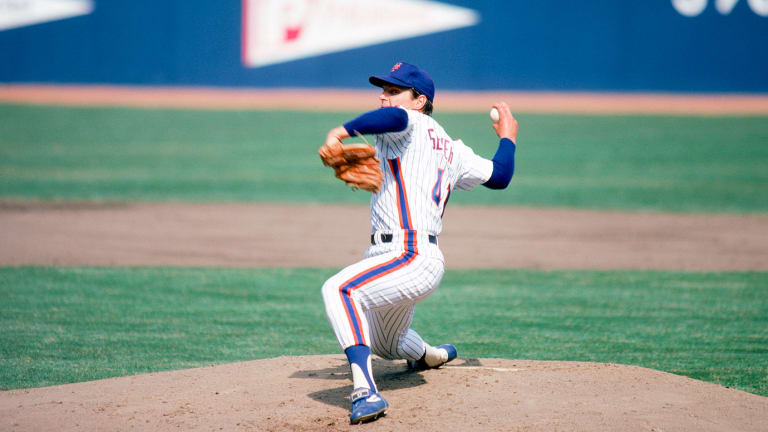 |
| https://metsmerizedonline.com/2020/09/mmo-roundtable-the-mmo-team-mourns-tom-seaver.html/ |
/cdn.vox-cdn.com/uploads/chorus_image/image/67347458/85958514.jpg.5.jpg) |
| https://www.lookoutlanding.com/2020/9/3/21419913/mariners-moose-tracks-9-3-20-taylor-trammell-tom-seaver-and-john-boyega |
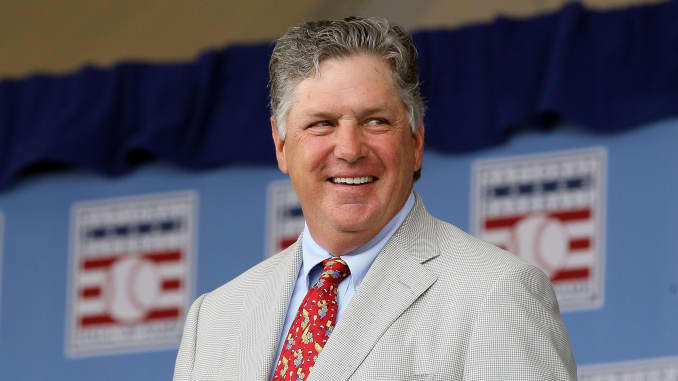 |
| https://www.cnbc.com/2020/09/02/tom-seaver-the-hall-of-fame-pitcher-who-was-the-heart-of-the-miracle-mets-has-died-at-75.html |
 |
| https://buffalonews.com/sports/baseball/tom-seaver-pitching-great-relished-his-buffalo-home-run/article_b181b278-eddb-11ea-891f-9b575b02fa32.html |
/cdn.vox-cdn.com/uploads/chorus_image/image/67346467/897674352.jpg.0.jpg) |
| https://www.beyondtheboxscore.com/2020/9/3/21419574/mlb-news-mets-legend-tom-seaver-passes-away-at-75 |
 |
| https://www.wsj.com/articles/baseball-hall-of-famer-tom-seaver-dies-at-75-11599098830 |
— YES Network (@YESNetwork) September 3, 2020
Genius idea from Uni Watch reader Joe Wagner: Since Tom Seaver famously had dirt on his right knee (due to his drop/drive motion), @Mets should memorialize him by rubbing dirt on their pants knees — or even wearing "dirty" patch on their knees — instead of a typical jersey patch. pic.twitter.com/YRmAheQDa2— Paul Lukas (@UniWatch) September 3, 2020
 |
| https://abc7.com/tom-seaver-dementia-covid-19-hall-of-fame-pitcher/6403109/ |
 |
| https://www.insideedition.com/baseball-legend-tom-seaver-dies-from-covid-19-complications-at-75-61649 |
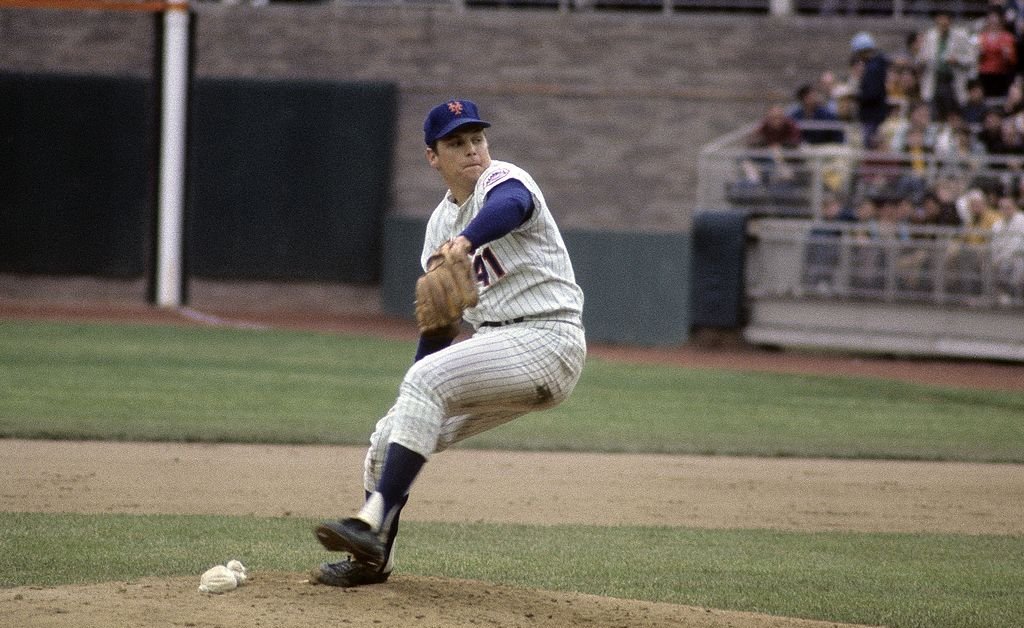 |
| https://time.com/5885839/tom-seaver-mets-covid/ |
| https://www.usatoday.com/story/sports/mlb/2020/09/02/tom-seaver-hall-fame-pitcher-dies-75/5699380002/ |
 |
| https://nypost.com/2020/09/03/nyc-kids-of-the-70s-always-had-tom-seaver-and-always-will-sherman/ |
 |
| https://41nbc.com/2020/09/03/tom-seaver-dies/ |
+++++++++++++++++++++++++++++++++++++++++++++++++++++++++++++++++++++++
+++++++++++++++++++++++++++++++++++++++++++++++++++++++++++++++++++++++
+++++++++++++++++++++++++++++++++++++++++++++++++++++++++++++++++++++++
- Bloggery committed by chris tower - 2009.04 - 10:10
- Days ago = 1890 days ago
- New note - On 1807.06, I ceased daily transmission of my Hey Mom feature after three years of daily conversations. I plan to continue Hey Mom posts at least twice per week but will continue to post the days since ("Days Ago") count on my blog each day. The blog entry numbering in the title has changed to reflect total Sense of Doubt posts since I began the blog on 0705.04, which include Hey Mom posts, Daily Bowie posts, and Sense of Doubt posts. Hey Mom posts will still be numbered sequentially. New Hey Mom posts will use the same format as all the other Hey Mom posts; all other posts will feature this format seen here.

No comments:
Post a Comment